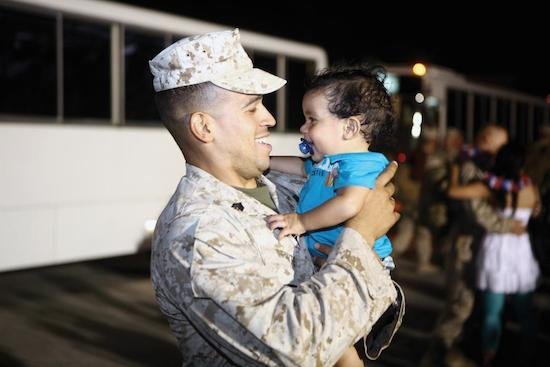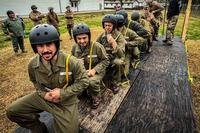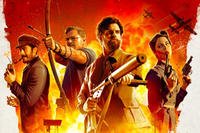
Coming Back With Wes Moore is a three-part series starting Tuesday May 13th on PBS stations around the country. The program attempts to present the experiences of the men and women who have served overseas in a more realistic context for the vast majority of Americans who don't have any direct connect to the military, to move beyond the rote "Thank you for your service" greetings men and women in uniform are used to hearing.
%embed1%
Counting Army vet Wes himself, Coming Back profiles 11 veterans and explores their experiences. Andy Clark is a currently working as a contractor in Afghanistan. Bobby Henline is launching a career as a standup comedian after an IED burned more than 40% of his body in Iraq. Brad Farnsley is dealing with the aftermath of convincing his best friend to enlist with him. Chris Phelan is currently an officer in the LAPD. His wife, Star Lopez, now serves as JAG in Kabul while Chris raises their daughter back in Los Angeles. Earl Johnson is a vet determined to improve his community in one of the poorest neighborhoods in Baltimore. Letrice Titus now works as a behavioral health specialist counseling veterans in crisis. Tammy Duckworth, a former helicopter pilot in Iraq, is now a congresswoman from Illinois. Stacy Pearsall suffered a traumatic brain injury during her service and now travels the country taking portraits of fellow vets. Taylor Urruela is attempting to make the JV baseball team at the University of Tampa after serious injuries to his legs.
The programs endeavor to present these men and women's lives as they actually are, to educate a country about both the sacrifices they made and the contributions they can make to our country going forward. Wes Moore talked to us about his experiences making the program.

So tell our readers about your background, who you are, and how you came to make this program.
I've been in the military since I was 17 years old. I actually first became familiar with the military and military system when I was sent to military school at age 13. I had no experience whatsoever. I didn’t have family in service, but I found something in military school that really attracted me.
When it came time for me to graduate from high school, I started thinking about exactly what I wanted to do with myself. The idea of leading soldiers was something that appealed to me and so I joined the military.
I spent time overseas after finishing my undergrad and grad school. The September 11 attacks happened right around the time that I was getting ready to leave for Oxford for a Rhodes Scholarship. That added a greater sense of context for the military service I had up to that point. I was already a First Lieutenant in the Army. At that moment, I knew that there was a responsibility I had to our country and a role I had to play with our armed forces.

I joined up with the 82nd Airborne Division, deployed with the 82nd Airborne Crew in Afghanistan. A few years ago, I started realizing how few Americans really had any idea of what it was like for service people, for their families.
I knew that as these wars were winding down and that combat operations were coming to an end, it wasn’t enough just for people to say, “Thanks for your service and thanks for what you’ve been doing for the past decade.” If they didn’t have a real clear human understanding of what has happened, of what the toll has been, and an understanding of the amazing people who are now returning back to our society, it would be a lost opportunity if Americans weren’t better able to appreciate that and understand how these people can contribute to our society.
I worked with PBS and signed on as executive producing and host for a show called “Coming Back. “ What “Coming Back” wants to do is to show a face to the past decade-plus of combat the American population and show the humanity of the men and women who are returning back to our society. Hopefully, that will help us all be smart and passionate in the way we think about their reintegration.

What led you to take the show to PBS?
PBS has historically been the absolutely best platform to be able to tell true, unfiltered stories. PBS wants to make sure that good, important stories get on the airwaves and they don’t want to sugarcoat them.
The fact is that this is tough material. This is tough stuff. At the same time, we want to make sure that people understand the importance of it getting the heavy, synthesized feel that far too often gets incorporated into television programming. PBS has been the perfect outlet for this program. Every expectation that I had has been fulfilled. They have been wonderful partners in this process.

It feels like people in the U.S. now are less connected to the people who have actually served than they may have been in previous generations. Do you think that’s an issue that these men and women are facing?
Definitely. I think one of the big issues is that less than one percent of Americans have any direct connection to these wars. Just from a statistical basis, that’s a big problem.
The other problem is that we have not really been asked to understand our veterans. We haven't been asked to, partially because these are such tough topics. It's not like there have been weekly briefings to the American people about what's going on. There haven’t been weekly proclamations that detail which unit is coming back home, how many people served in the unit along with some stories about what they experienced during their service.
There's been a significant disconnect between the wars and the people who live in the country that we have been fighting to protect and to serve.

I've been watching some recent documentaries about Vietnam veterans and I’ve been amazed at the amount of footage that’s available of those guys in combat. It's something we haven't seen from Iraq and Afghanistan. It's like people just don’t have any idea what happened over there at all.
It's really unfortunate. Part of the challenge that we have with the reintegration process is the communications between the two sides. There isn't really even a basis for beginning the conversation.
There’s a real level of frustration. And it's not a frustration with people who didn’t serve. Even with my own family, what they wanted with all their hearts was to better understand what I went through. They wanted to understand. They wanted to be able to have conversations with me.
But what do you say? How do you begin that conversation? And, in many cases, the default reaction is, “Well, I don’t want to upset and I don’t want to trigger anything, so therefore I'll say nothing.” And the problem is that, for the service person, when that’s the default reaction that we just say nothing, it makes service people feel like that you don’t appreciate or understand what we went through, nor have a curiosity to appreciate what we went through.
It’s a contradiction. There's real desire for connection but there's a large communication disconnect that we have to do a better job of bridging. I hope we can do that with “Coming Back.”

It really feels like the program is aimed at people who have very little familiarity with the military.
That was intentional because we understand that the vast majority of people who will watch the show are people who are not vets of Iraq or Afghanistan, who don’t know what it's like to watch a loved one get on a plane to leave for a year, who don’t know what it's live through the weeks before the reintegration process, where they have the excitement of someone coming home, but they’re nervous because they're not sure who exactly the person is coming back.
We wanted the viewer, who's probably a novice to this, to have a better understanding that, as we put on men and women in harm's way and conduct combat operations around the world, there needs to be a weight that comes with that. And not just for the people who are ordering it, but, frankly, for the people back home who might not have a direct connection to it.

It will be interesting to see the reaction to the show from some people who live deep in military culture, because I don’t think a lot of them appreciate how far that bridge is for people who have no connection.
Or how deep that bridge is. Even in military circles, when people who are deployed come back home there's just like this big, collective sigh of relief.
It's like, “Oof, well, I'm glad that’s done and I'm glad they’re safe.” And, yes, we're glad they’re safe, but people also have to appreciate that the reintegration process requires just as much care and just as much of a delicate touch as the actual deployment process.
How did you choose veterans that you profile in the show?
That was actually one of the most fun things about the process. Some of them are friends. Some of them were people who we found after scouring all around the country. We went around finding interesting stories, finding people, talking to the units that were recently redeployed. We literally went through hundreds of different candidates to find our people.
One thing I wanted to show is that these are all remarkable people, but in many ways their stories are not extraordinary. You know, whether you're talking about Bobby Henline, whether you're talking about Star Lopez, whether you're talking about Taylor Urruela, they're all amazing people, but frankly they represent large populations who are facing very similar type of opportunities and challenges at the same time. And I thought they were all incredibly impressive, but all incredibly representative.

It’s notable what an extensive a period of time you were able to cover in these peoples' lives. How long did it take you to make the program?
It took a little over two years to get everything done. I give a tremendous amount of credit to these people because they let us into their lives in a very intimate way at a very vulnerable moment.
I really respect them going through the filming process while we figured out what exactly were the stories that we were trying to tell. What was it that we were hoping to capture and what was it that we were hoping would be the takeaway? What was interesting is there were certain elements of all the stories that really uncovered themselves right before our eyes.

If you take a look at Earl Johnson’s story, where the news of the fabrication of Earl's military records literally happened on camera. So our challenge was how exactly to deal with all of the elements while a camera is still rolling. I think Earl is another perfect example of someone who is actually very representative of a lot of things that are happening in military culture. That’s actually what we wanted to show.
We just wanted to be honest as we possibly could about all these stories, making sure that we're not sugarcoating, that we're not acting like there is no issue, but at the same time not reinforcing what I think is just a horrific stereotype about many soldiers that’s being developed in many circles, that everybody who deployed is somehow damaged. That’s just not fair. It's just not accurate. And frankly, it's a disservice.

Have you had an opportunity to show “Coming Back” to many people yet?
We have. We showed it around the country as part of a rollout to make sure that people understand the real intent behind the show. There's one thing we were very clear about at the very beginning: this is not just about putting another show on television. This is about being part of a much bigger conversation and having the show be the catalyst.

It does feel more like an advocacy piece than a documentary.What do you hope comes from people having the chance to see this?
Even if they don’t have a direct connection, I want people, as they're hearing and talking about military issues, to have an understanding that goes beyond the numbers. When they think about veterans' issues and hear about things like unemployment or opportunity, I want them to see Bobby. I want them to see Stacy. I want them to see Andy. I want them to see these faces because I believe that can add context. Stories promote action.
I want action done, not just the ways of being able to help, but, you know, but being able to look at our veterans not necessarily as a charity, but look at them as assets. Look at them as extraordinary men and women who now have a tremendous gift that they have given and can continue to give. We just have to do a better job of being able to reflect that understanding.
I’m very excited for the folks, for the readership and for the audience at Military.com to see the show. I'm also really excited that they go and share it with their civilian friends. I'm excited that they can tell their friends, many of whom might not have any connection besides them to the military, to check this piece out.
What we’ve really tried to do is to inspire a much more human approach to what the end of combat operation means to us, to our family. And present the rest of the country with an opportunity to think about it in a smart way.




